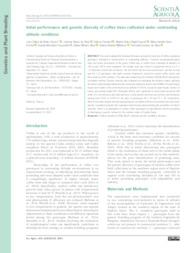Initial performance and genetic diversity of coffee trees cultivated under contrasting altitude conditions.
Initial performance and genetic diversity of coffee trees cultivated under contrasting altitude conditions.
Author(s): SENRA, J. F. de B.; SILVA, J. A. da; FERREIRA, A.; ESPOSTI, M. D. D.; FERRAO, M. A. G.; FASSARELLA, K. M.; SILVA, U. R.; MILHEIROS, I. S.; SILVA, F. G. da
Summary: This work evaluated the initial performance and genetic diversity of Coffea canephora genotypes cultivated in environments at contrasting altitudes. Fourteen morphophysiological traits and seven descriptors of the genus Coffea spp. of coffee trees cultivated at altitudes of 140 m and 700 m were evaluated. The design used was Federer’s augmented block in a 2 × 112 factorial scheme with six blocks. The first factor was the two environments, and the second was the 112 genotypes, with eight common treatments, being five conilon coffee clones and three arabica coffee cultivars. The data were analyzed by the method of REML/BLUP and genetic correlation method. Genetic diversity was evaluated by estimating the distance matrix, applying the Gower methodology followed by the clustering method by Tocher and UPGMA. The phenotypic means were higher in the environment at an altitude of 700 m, except for plant height, number of leaves, and canopy height (CH). Genotypic effects were significant for most traits except for leaf width, CH, unit leaf area, and total leaf area. A wide genetic diversity was verified, with distances varying from 0.037 to 0.593 for the pairs of genotypes 26 × 93 and T7 × 76, respectively. Most of the traits studied showed high genotypic correlation with the environment and expressive genetic correlation between the evaluated traits thereby demonstrating the possibility of indirect selection. There is an adaptation of conilon coffee genotypes to high altitudes and the possibility of developing a specific cultivar for the southern state of Espírito Santo.
Publication year: 2023
Types of publication: Journal article
Unit: Embrapa Coffee
Keywords: Coffea Canephora, Genetic variance, Genotype, Seed trees
Observation
Some of Embrapa's publications are published as ePub files. To read them, use or download one of the following free software options to your computer or mobile device. Android: Google Play Books; IOS: iBooks; Windows and Linux: Calibre.
Access other publications
Access the Agricultural Research Database (BDPA) to consult Embrapa's full library collection and records.
Visit Embrapa Bookstore to purchase books and other publications sold by Embrapa.

